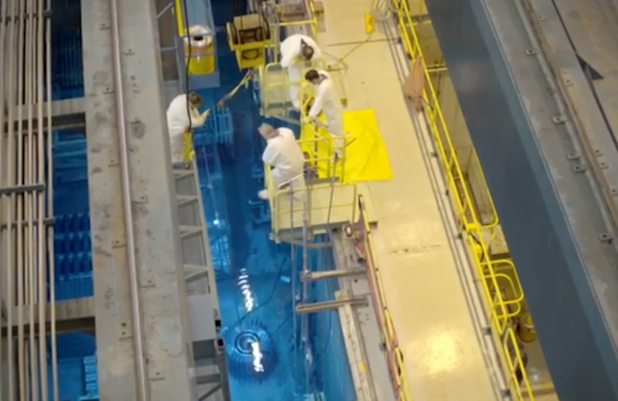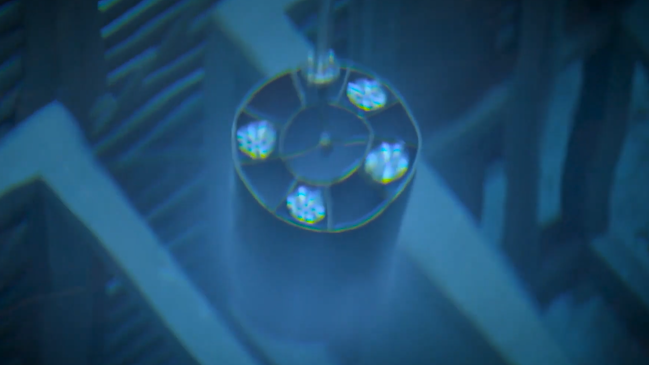Medical isotopes created in Bruce County will no longer be shipped overseas for processing
Bruce Power is quickly becoming one of the world’s largest producers of medical isotopes that fight and detect cancer around the globe – but on Friday the government and nuclear operator announced that they are working together to start processing those medical isotopes within Bruce County instead of shipping them overseas for processing.
“We're going to add some facilities either on site or very close to site to process these isotopes, which are coming outside of the reactor. [That means] we can get them into the drug much much faster, and go to the patient as fast as possible,” said Bruce Power CEO and President, Eric Chassard.
The new medical isotope processing facility will be located either right on the Bruce Power site, or in the Bruce Energy Centre near the nuclear plant. This means that instead of shipping the medical isotopes all the way to Germany for processing like they were previously, they’ll be processed within a few hundred metres of where they’re produced.
 Medical isotope production at Bruce Power nuclear station near Kincardine (Source: Bruce Power)
Medical isotope production at Bruce Power nuclear station near Kincardine (Source: Bruce Power)
“What this means is that we're saving time - and when you're producing these medical isotopes, that time is money. And the closer we can get these medical isotopes to people, the more lives we're going to save. So, this is about economic development for sure, it's about health care too. It's about improving the quality of life of tens of thousands of families that are affected by cancer every week,” said Ontario’s Energy Minister, Stephen Lecce, who was at Bruce Power for Friday’s announcement.
 Ontario’s Energy Minister, Stephen Lecce announces plans for a medical isotope processing facility in Bruce County, Friday, November 8 (Scott Miller/CTV News London)
Ontario’s Energy Minister, Stephen Lecce announces plans for a medical isotope processing facility in Bruce County, Friday, November 8 (Scott Miller/CTV News London)
Not only will Bruce Power soon start processing their medical isotopes closer to home, but they’ll also be producing a lot more of them. The nuclear power generator plans to more than double their production, of isotope lutetium-177, used primarily to detect and kill prostate cancer cells.
“Before it was very expensive, like $55,000 to $60,000 for one dose, and it was very hard to get. Now with our new production, we are going to produce 400,000 of doses every year - so the cost of the doses will come down to a couple of thousand dollars,” said Chassard.
Canada used to import most of their medical isotopes from Europe, before Bruce Power started producing them in earnest in 2022. The new processing facility announced today, and production lines expands on a partnership Bruce Power has with the Saugeen Ojibway Nation to share in isotope proceeds.
 Medical isotope production at Bruce Power nuclear station near Kincardine (Source: Bruce Power)
Medical isotope production at Bruce Power nuclear station near Kincardine (Source: Bruce Power)
“We will work with anybody that is willing to hear our voice and allow us a seat at the table and allow us a share of the dividends, which is only right,” said Chippewas of Nawash Unceded First Nation Chief, Greg Nadjiwon.
Minister Lecce said Ontario will be leaning heavily on nuclear as it aims to meet a rise in energy demand, which the government expects to more than double between now and 2050.
“We become a one stop integrated nuclear ecosystem where we're doing everything from generation to production to medical isotopes to refining. We're doing it all here in Ontario, and the world is turning to Ontario as a source of leadership for clean energy and for life saving medical isotopes,” said Minister Lecce.
Chassard said Bruce Power is ready for the challenge ahead.
CTVNews.ca Top Stories

W5 Investigates A 'ticking time bomb': Inside Syria's toughest prison holding accused high-ranking ISIS members
In the last of a three-part investigation, W5's Avery Haines was given rare access to a Syrian prison, where thousands of accused high-ranking ISIS members are being held.
As Australia bans social media for children, Quebec is paying close attention
As Australia moves to ban social media for children under 16, Quebec is debating whether to follow suit.
Irregular sleep patterns may raise risk of heart attack and stroke, study suggests
Sleeping and waking up at different times is associated with an increased risk of heart attack and stroke, even for people who get the recommended amount of sleep, according to new research.
California man who went missing for 25 years found after sister sees his picture in the news
It’s a Thanksgiving miracle for one California family after a man who went missing in 1999 was found 25 years later when his sister saw a photo of him in an online article, authorities said.
Trudeau Liberals' two-month GST holiday bill passes the House, off to the Senate
The federal government's five-page piece of legislation to enact Prime Minister Justin Trudeau's promised two-month tax break on a range of consumer goods over the holidays passed in the House of Commons late Thursday.
Notre Dame Cathedral: Sneak peek ahead of the reopening
After more than five years of frenetic reconstruction work, Notre Dame Cathedral showed its new self to the world Friday, with rebuilt soaring ceilings and creamy good-as-new stonework erasing somber memories of its devastating fire in 2019.
Canada Post temporarily laying off striking workers, union says
The union representing Canada Post workers says the Crown corporation has been laying off striking employees as the labour action by more than 55,000 workers approaches the two-week mark.
Can't resist Black Friday weekend deals? How to shop while staying within your budget
A budgeting expert says there are a number of ways shoppers can avoid getting enveloped by the sales frenzy and resist spending beyond their means.
Montreal shopping mall playing 'Baby Shark' song to prevent unhoused from loitering
A shopping mall and office complex in downtown Montreal is being criticized for using the popular children's song 'Baby Shark' to discourage unhoused people from loitering in its emergency exit stairwells.


































